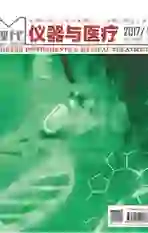上消化道内镜黏膜下剥离术后食管狭窄的原因及防治
2018-01-09曹世堂刘克祥杨立宇黄敏捷王玉华
曹世堂 刘克祥 杨立宇 黄敏捷 王玉华
[摘 要] 目的:分析上消化道內镜黏膜下剥离术(ESD)术后食管狭窄的原因,探讨防治对策。方法:整理行ESD术治疗,术后随访时间≥6个月的283例早期食管癌患者临床资料,按照其随访期间食管狭窄发生情况分为发生组、未发生组,计算术后食管狭窄发生率,总结影响患者ESD术后食管狭窄的影响因素,并使用Spearman等级相关分析,计算影响因素与食管狭窄程度的相关性。结果:283例患者中,共有33例术后发生食管狭窄,发生率为11.66%。Logistic多因素回归分析得出浸润深度m3为影响上消化道ESD术后食管狭窄的独立危险因素,病变环周范围<1/2为保护因素(P<0.05)。Spearman等级相关分析显示病变环周范围、病变浸润深度与食管狭窄程度均具有关联性(P<0.05)。结论:上消化道ESD术后食管狭窄与病变环周范围、浸润深度有关,早期识别高危因素并实施预防性球囊扩张有望降低术后食管狭窄风险。
[关键词] 上消化道肿瘤;内镜黏膜下剥离术;食管狭窄;防治
中图分类号:R571 文献标识码:A 文章编号:2095-5200(2017)05-048-03
DOI:10.11876/mimt201705020
Causes and preventions of esophageal stenosis after endoscopic submucosal dissection of upper gastrointestinal tract CAO Shitang1, LIU Kexiang2, YANG Liyu3, HUANG Minjie4, WANG Yuhua5.
(1. Department of Gastroenterology,256 Clinical Department, Bethune International Peace Hospital;2. Department of Neurology, 256 Clinical Department, Bethune International Peace Hospital;3.Medical Service, 256 Clinical Department, Bethune International Peace Hospital;4. Department of Infectious Disease, 256 Clinical Department, Bethune International Peace Hospital, Zhengding050800, china;
5. Department of Oncology,Fourth Hospital of Hebei Medical University, Shijiazhuang 050081, china)
[Abstract] Objective: The objective of this study was to analyze the causes of esophageal stenosis after endoscopic submucosal dissection (ESD) of upper gastrointestinal tract and to explore the countermeasures of prevention and cure. Methods: The clinical data of 283 cases of early esophageal cancer patients who had had ESD treatment and whose postoperative follow-up time≥6 months were collected and the cases were divided into occurrence group and no occurrence group according to the occurrence of esophageal stenosis during follow-up period. The incidence rate of postoperative esophageal stenosis was calculated, and the influencing factors of esophageal stenosis after ESD surgery were summarized. The correlation between the influencing factors and the degree of esophageal stenosis was calculated by Spearman rank correlation analysis. Results: There were 33 cases of esophageal stenosis after ESD surgery in 283 patients, with an incidence rate of 11.66%. Logistic multivariate regression analysis showed that the depth of invasion, m3, was an independent risk factor of esophageal stenosis after ESD surgery of upper gastrointestinal tract, and the range of lesion cycle<1/2 was a protective factor (P<0.05). Spearman rank correlation analysis showed that the range of lesion cycle, the depth of invasion and the degree of esophageal stenosis were related (P<0.05). Conclusions: The esophageal stenosis after ESD surgery of upper gastrointestinal tract is related to the range of lesion cycle and the depth of invasion. Early identification of high-risk factors and implementation of prophylactic balloon dilatation are expected to reduce the risk of postoperative esophageal stenosis.endprint
[Key words] upper gastrointestinal tumors; endoscopic submucosal dissection; esophageal stenosis; prevention and cure
内镜黏膜下剥离术(ESD)能够显著减少肿瘤残留、降低局部复发率[1]。随着ESD技术的不断成熟,较大的食管病变甚至是环周型食管病变也可得到有效治疗,但黏膜下较大范围切除在一定程度上增加了术后迟发性出血、穿孔、消化道出血等并发症发生风险[2]。食管狭窄是食管癌术后最常见并发症之一,且往往伴随吞咽困难甚至吸入性肺炎[3-4]。因此,本研究就上消化道ESD术后食管狭窄的原因进行了回顾性分析。
1 资料与方法
1.1 对象
整理2014年3月至2016年12月283例接受ESD的早期食管癌患者临床资料,患者术后随访时间≥6个月;排除术后接受二次手术治疗或放射治疗者以及术后病理提示肿瘤浸润深度超过黏膜下层1/3者。283例患者中,男185例,女98例,年龄31~85岁,平均(67.04±8.92)岁;病变位置:上段10例,中段205例,下段58例,连接部10例;合并症:糖尿病37例,高血压53例。
患者由经验丰富的同手术组医师实施,术中所用设备、仪器型号均相同,其中51例患者病变分次切除[5],232例患者病变完整切除。术毕回收并展开病变黏膜,固定于软木板上,标记口侧与肛侧端,测量病变最大直径,参照WHO制定的相关标准判断病理分型与浸润深度,浸润深度判断标准[6]:m:肿瘤位于上皮内层;m2:肿瘤浸润黏膜固有层;m3:肿瘤浸润黏膜肌层;sm1:肿瘤浸润深度超过黏膜下层1/3。
1.2 分析方法
食管狭窄判断标准[7]:直径9.8 mm标准内镜难以通过食管管腔,合并摄食、消化功能障碍;食管狭窄分级标准[8]:轻度:0.6 cm≤食管直径0.6<1.0 cm,可进半流食;中度:0.3 cm≤食管直径<0.6 cm,仅可进流食;重度:食管直径<0.3 cm,流食摄食困难。按照其随访期间食管狭窄发生情况,将其分别纳入发生组、未发生组,计算术后食管狭窄发生率并比较发生于未发生组临床资料,总结影响患者ESD术后食管狭窄的影响因素,并使用Spearman等级相关分析,计算影响因素与食管狭窄程度的相关性,数据以SPSS19.0软件进行统计。
2 结果
共有33例术后发生食管狭窄,发生率为11.66%,狭窄发生时间为术后3周~3个月,平均时间(1.96±0.35)个月;狭窄程度:轻度6例(18.18%),中度12例(36.36%),重度15例(45.45%);发生食管狭窄患者中,31例经2~10次球囊扩张治疗后症状改善,其余2例多次球囊扩张治疗效果不佳,行覆膜支架治疗后症状好转。
发生组与未发生组病灶直径、病变环周范围、浸润深度比较,差异有统计学意义(P<0.05)。见表1。
Logistic多因素回归分析浸润深度m3为影响上消化道ESD术后食管狭窄的独立危险因素,病变环周范围<1/2为保护因素(P<0.05)。
Spearman等级相关分析示,病变环周范围(r=0.481)、病变浸润深度(r=0.690)与食管狭窄程度均具有关联性(P<0.05)。
3 讨论
食管狹窄是食管癌ESD术后常见并发症之一,其原因与食管黏膜缺损面积较大、功能长时间受损有关[9],此外,食管创面愈合后创面纤维化的进展、创面挛缩以及瘢痕的形成,也可加剧炎症反应、细胞增生及重构,导致食管狭窄发生[10-11]。此次研究283例患者术后食管狭窄发生率达11.66%,与过往报道接近[12]。
病变环周范围超过1/2意味着病变范围较大,ESD术中需实施大面积食管黏膜切除,术后造成的人工溃疡面随之增大,同时,溃疡的纤维化与疤痕化也愈发严重,均导致食管狭窄风险大幅上升[13]。溃疡的修复过程包括黏膜缺损周围的正常上皮细胞再生以及肉芽组织成熟为结缔组织两个过程,术后早期,食管溃疡炎性反应占据主导,而较大的切除范围往往导致炎性反应延迟消退、食管壁顺应性恢复缓慢,也在一定程度上增加了食管狭窄风险[14-15]。此次研究回归分析、相关性分析都提示随着病变环周范围的增加,患者术后食管狭窄程度也有所上升,说明病变环周范围大是导致食管狭窄的危险因素。
灶浸润深度达到m3级意味着黏膜肌层已受到侵犯,此时固有肌层受到严重破坏,肌纤维萎缩、纤维化明显,是导致食管狭窄发生的重要原因;同时,较深的浸润程度对黏膜切除深度也提出了较高的要求,术中深层组织的热力损伤可导致组织坏死形成瘢痕,造成固有肌层萎缩、肌细胞去分化并向成纤维细胞转变,影响创面愈合过程,诱发食管狭窄发生[16]。因此,随着病灶浸润深度的增加,患者术后食管狭窄分级亦呈上升趋势。
关于ESD术后食管狭窄的防治,当前临床尚无统一结论,多数学者认为,口服激素治疗能够在一定程度上降低术后食管狭窄发生风险,但也有研究指出,激素在预防食管狭窄方面的作用有限[17]。在激素防治作用尚不明确的前提下,笔者认为,可注重患者术后食管狭窄风险的早期评估,对于高危患者实施早期预防性球囊扩张治疗。也有学者建议,术中结合组织细胞工程支架、自体黏膜上皮移植、两步法边缘组织切除等新技术,可能能够抑制炎症反应、促进黏膜再生,从而预防食管狭窄发生[18]。
参 考 文 献
[1] Iizuka T, Kikuchi D, Yamada A, et al. Polyglycolic acid sheet application to prevent esophageal stricture after endoscopic submucosal dissection for esophageal squamous cell carcinoma[J]. Endoscopy, 2015, 47(04): 341-344.endprint
[2] Sakaguchi Y, Tsuji Y, Ono S, et al. Polyglycolic acid sheets with fibrin glue can prevent esophageal stricture after endoscopic submucosal dissection[J]. Endoscopy, 2015, 47(04): 336-340.
[3] 王华, 刘枫, 李兆申. 食管内镜黏膜下剥离术后狭窄的发生机制和预防[J]. 中华消化内镜杂志, 2015, 32(4): 266-269.
[4] Takahashi H, Arimura Y, Okahara S, et al. A randomized controlled trial of endoscopic steroid injection for prophylaxis of esophageal stenoses after extensive endoscopic submucosal dissection[J]. BMC Gastroenterol, 2015, 15(1): 1.
[5] Miwata T, Oka S, Tanaka S, et al. Risk factors for esophageal stenosis after entire circumferential endoscopic submucosal dissection for superficial esophageal squamous cell carcinoma[J]. Surg Endosc, 2016, 30(9): 4049-4056.
[6] 谢艳, 陈萌, 胡兵,等. 预防食管EMR/ESD术后狭窄的方法及进展[C]// 西南地区消化病学术会议暨2014贵州省消化病及消化内镜学术年会. 2014.
[7] Kishida Y, Kakushima N, Kawata N, et al. Complications of endoscopic dilation for esophageal stenosis after endoscopic submucosal dissection of superficial esophageal cancer[J]. Surg Endosc, 2015, 29(10): 2953-2959.
[8] Oliveira J F, Moura E G H, Bernardo W M, et al. Prevention of esophageal stricture after endoscopic submucosal dissection: a systematic review and meta-analysis[J]. Surg Endosc, 2016, 30(7): 2779-2791.
[9] Ishida T, Morita Y, Hoshi N, et al. Disseminated nocardiosis during systemic steroid therapy for the prevention of esophageal stricture after endoscopic submucosal dissection[J]. Dig Endosc, 2015, 27(3): 388-391.
[10] Bhatt A, Abe S, Kumaravel A, et al. Indications and techniques for endoscopic submucosal dissection[J]. Am J Gastroenterol, 2015, 110(6): 784.
[11] 吴楠楠, 陈明锴, 曾西, 等. 食管病变内镜黏膜下剥离术后狭窄的预防[J]. 中华消化内镜杂志, 2017, 34(4): 301-304.
[12] Chevaux J B, Piessevaux H, Jouret-Mourin A, et al. Clinical outcome in patients treated with endoscopic submucosal dissection for superficial Barretts neoplasia[J]. Endoscopy, 2015, 47(2): 103-112.
[13] Nagami Y, Shiba M, Tominaga K, et al. Locoregional steroid injection prevents stricture formation after endoscopic submucosal dissection for esophageal cancer: a propensity score matching analysis[J]. Surg Endosc, 2016, 30(4): 1441-1449.
[14] Abe S, Sakamoto T, Takamaru H, et al. Stenosis rates after endoscopic submucosal dissection of large rectal tumors involving greater than three quarters of the luminal circumference[J]. Surg Endosc, 2016, 30(12): 5459-5464.
[15] Pimentel-Nunes P, Dinis-Ribeiro M, Ponchon T, et al. Endoscopic submucosal dissection: European society of gastrointestinal endoscopy (ESGE) guideline[J]. Endoscopy, 2015, 47(09): 829-854.
[16] Lib?nio D, Pimentel-Nunes P, Dinis-Ribeiro M. Comment on:“Prevention of Esophageal Stricture After Endoscopic Submucosal Dissection: A Systematic Review”[J]. World J Surg, 2017, 41(3): 896-897.
[17] 孙银平. 糖皮质激素预防食管内镜粘膜下剥离術(ESD)术后食管狭窄的有效性研究:一项meta分析[D]. 杭州:浙江大学, 2015.
[18] H?bel S, Dautel P, Baumbach R, et al. Single center experience of endoscopic submucosal dissection (ESD) in early Barrett s adenocarcinoma[J]. Surg Endosc, 2015, 29(6): 1591-1597.endprint
